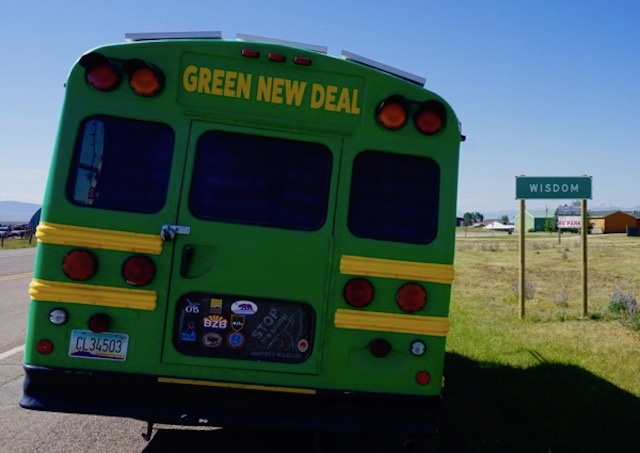Bernie Sanders just released his climate plan, and it is truly superb. Hit this link and read the whole thing!
I am hugely impressed by the obvious scientific, policy, and political expertise, vision, commitment to justice, and sense of history that informed that plan.
A few bulleted thoughts, on what is both an extremely comprehensive and detailed roadmap.
The Plan begins with critically important observations and principles that ground a vision of the future in the Green New Deal, with a look back to continuity with and building upon the original New Deal.
That historical recognition – and the plan’s future focus and programmatic framework – can help build the movements and political coalitions necessary to make the Plan a reality. In that sense, the Plan will survive regardless of whether Bernie Sanders is elected President.
I was slightly put off with how the plan initially mentions the FDR crisis as of “the 1940’s” (not the 1930’s depression) and legacy in light of the mobilization for WW II – while of course we need a national mobilization driven by the leadership, resources, and regulatory power of the federal government, I dislike war metaphors.
But that shortcoming is overcome by extensive arguments that are framed in light of the original New Deal and the outline of modernized programs that are based on New Deal, like the CCC.
Importantly, the Sanders Plan openly acknowledges and confronts the shortcomings and racial injustices of the original New Deal, by making a commitment to an “explicit choice to include black, indigenous, and other minority communities”. Multiple program elements of the plan explicitly recognize historic injustice, disproportionate burdens, and the need to incorporate justice in everything from the design of the programs to the allocation of resources and hiring of people.
If these commitments are communicated properly, they can go a long way to advancing the objectives of the reparations, Black Lives Matter, and environmental justice advocates, while maintaining a universalist philosophy that is insulated from attacks as just more divisive “identity politics”.
Similarly, the plan does not break down on urban versus rural grounds – there is plenty in the plan that benefits rural and agricultural regions and economies. This is not an elite coastal urban plan.
The Plan avoids and resolves contradictions between economic policy and cultural policy – for a superb discussion of that dilemma, see: The End of Progressive Neoliberalism and From Progressive Neoliberalism to Trump—and Beyond. This is a political minefield, but the Sanders plan brilliantly navigates these issues.
The Sanders plan recognizes that we are in a climate crisis, but that crisis provides a huge opportunity “to build a just and equitable future”. The plan declares a “climate emergency” and emphasizes that we must “act immediately”.
The plan’s focus on the future invites democratic dialogue and inspires imagination, ideals, hopes, the public interest, solidarity and collective action over fear, resentment, despair, alienation, and private individual competition and economic self interest.
These are democratic socialist values of particular importance to the younger generation, who will be more heavily impacted by climate chaos. This is the essence, internationally, of Extinction Rebellion and domestically, the Sunrise Movement, the youth group who we all owe a great debt of gratitude to for putting the Green New Deal on the political agenda. (The Green Party first released a “Green New Deal” program over a decade ago.)
Programmatically, the plan is comprehensive and it synthesizes multiple climate, economic and social problems and outlines concrete solutions. The plan is very detailed – as Sanders has said, it “puts meat on the bones of the Green New Deal”
And there is a lot of meat there!
The plan would “transform the energy system” to 100% renewable energy – publicly generated , profit free and democratically controlled.
The Plan seeks a carbon free economy, would create 20 million union jobs with good pay and benefits, phase out fossil fuels and nukes, regulate greenhouse gas emissions, fully electrify and decarbonize the transportation sector, greatly expand public transportation and high speed rail, pledge a world leadership role, invest in justice, rebuild crumbling infrastructure, create a national material recycling program based on corporate “buy back” (this could be better presented as source reduction), build publicly owned broadband, build 7.4 million units of affordable housing, conserve public lands, including creating a new CCC, hold fossil polluters accountable and make them pay for pollution, eliminate fossil subsidies, keep fossil fuels in the ground (but this is limited in scope to public lands), end fossil infrastructure permits, ban fracking and mountaintop removal coal mining, ban imports and exports of fossil fuel, fair transition: guarantee incomes and jobs for displaced fossil workers, ensure justice for frontline communities, extend civil rights protections to environmental justice communities in recognition of disproportionate burden and cumulative impact, invest in urban parks, empower and provide incentives to farmers, foresters and ranchers, transition to organic agriculture, regulate factory farm pollution, invest in family farms while breaking up huge corporate farms, ensure justice for dispossessed black farmers (reparations would have been a better thrust), promote local based farms/markets, and promote co-operatives and community owned land! Whew!
And that’s just some of the program. A discussion is far too much for a Wolfenotes post – we are, after all, merely “notes”. That’s why we suggest you read the plan yourself – and pass it on.


Pingback: WolfeNotes.com » NJ Senate Urged To Mandate “Climate Impact Statements”
Pingback: WolfeNotes.com » The WaPo & Corporate Democrats Have Gone John Bircher – McCarthyite
Pingback: WolfeNotes.com » Structural Racism “Works” For the Same Reasons That The Environmental Justice Bill Will Fail